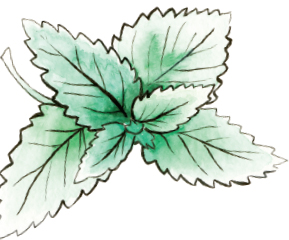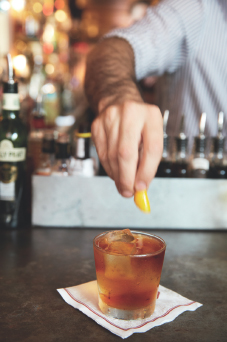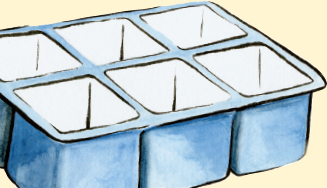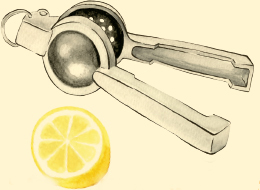THE “DRY SHAKE” AND “WET SHAKE” (ADVANCED!)
It’s rare that you’ll shake ingredients together without ice, with one exception: When you’re using egg. Egg white is a classic cocktail ingredient; when shaken together with liquids, it develops a frothy, silky texture (but, don’t worry, doesn’t make the drink taste “eggy” at all). You’ll also see drinks that call for whole eggs, though today that’s less common.
In order to properly fluff up the egg white, bartenders generally “dry shake”: Combine all the ingredients in a shaker, and shake without ice for 8 to 10 seconds. Then they add ice and shake again to chill and further combine; that’s the “wet shake.”

GARNISH LIKE A PRO
It’s easy to assume that garnishes are optional—after all, the real cocktail is what’s in the glass, right? But most garnishes are far more than ornamental. (Excluding cocktail umbrellas, which are just plain fun.) When a Martini gets a “twist” of lemon, it’s not only for the aesthetics: Twisting a strip of lemon peel over the glass releases citrus oils, leaving a thin sheen on the surface of the cocktail. What we perceive as the taste of a drink is inextricably linked to its scent, and these garnishes contribute essential aromas.
HOW TO GARNISH WITH HERBS
Whether you’re working with mint, rosemary, basil, or other herbs, there are a few cardinal rules: Make sure the herbs are clean, fresh, and cosmetically appealing (nothing lowers expectations for a drink like a wilted garnish). For rosemary, that means a long, intact stem; for basil and mint, choose the best-looking sprig, where several leaves are still attached.
Before garnishing with herbs, bartenders will slap them lightly against their palms. Why? It helps to release their aromatic oils. Do a quick test: Take a whiff of a few basil leaves; then slap them against your palm and sniff again. The scent will be much more powerful the second time around.
One More That’s It, Extra Fancy
HOW TO MAKE A TWIST
For a lemon, orange, grapefruit, or lime twist, use a sharp paring knife or vegetable peeler to cut a long, thin slice of peel—at least an inch and a half long, and half an inch wide. Try to get mostly the colored peel, avoiding the white pith as much as possible.
After your cocktail is poured into the glass, finish with the twist: Hold it by both edges over the surface of the drink, colored side down, and quickly pull the edges up and together, to spritz its oils over the cocktail. (If you’ve done it right, you’ll smell citrus immediately, and with clear cocktails, you should be able to see a thin sheen on the drink’s surface.) Some bartenders will then lightly rub the twist around the rim of the cocktail glass to further distribute its oils before dropping it in. (Generally a twist is left in the cocktail, but in some cases only the oils are desired, and the peel itself is discarded.)
HOW TO MAKE A FLAMING TWIST (ADVANCED!)
Most bartenders (and most bar-goers) love a dramatic presentation—and nothing is quite as dramatic as fire. Citrus oils are flammable, so catching them with a flame as they’re sprayed over a drink causes a quick burst of fire. A proper flaming twist will give your drink a powerful, smoky aroma, and give your audience quite a show, though it’s difficult to pull off. This is a trick best attempted in a sober state, well clear of anything else that’s flammable.
Instructions: Make a nice, big citrus peel (generally orange or grapefruit), according to the directions above; the longer and broader it is, the bigger the flame you’re likely to get. Over the surface of the drink, hold the peel (colored side down) in one hand, and a lighter in the other. Pass the flame several times back and forth over the peel, warming it up, before holding the flame right under the peel and spritzing the citrus oils over the drink—if you’ve aimed correctly and made a proper peel, you should be rewarded with a burst of flame.
HAVE FUN WITH IT
“Functional garnishes are ideal, but sometimes a garnish can be about pure aesthetics,” says Will Elliott of Maison Premiere. In other words, presentation matters. “I believe, elementally, that the visual is right alongside all the other senses for enjoying cocktails. Everything plays a part in enjoying the drink.”




